Christopher Hansen’s NASA-funded Lattice Structures Have Applications Here on Earth

Originally intended to be strong yet lightweight materials for constructing large structures in space, such as the International Space Station, Assoc. Prof. Christopher Hansen’s work on 3D-printed lattice structures has pivoted and could now be used in consumer products such as helmets and shoes.
11/15/2021
By Ed Brennen
Assoc. Prof. Christopher Hansen, chair of the Mechanical Engineering Department, hopes to add ultra-lightweight and energy-absorbing lattice structures to that list.
In 2014, Hansen was awarded a three-year, $579,000 NASA Early Career Faculty Space Technology Research Grant to pursue his project, “Design and Fabrication of Aerospace-Grade Digital Composite Materials.” Using computer modeling and 3D printing, his goal was to create a library of interlocking components, almost like space Legos, that NASA could deploy as lightweight and reusable construction materials in orbit.
“The project morphed over time, as often happens in research,” says Hansen, who ended up designing and fabricating intricate lattice structures with characteristics that could make them just as useful here on Earth in everyday items such as helmets and shoes.
Working with then-Ph.D. student Xiao Liu ’15, ’19, Hansen found a way to create carbon-fiber composite rods that connect between nodes — much like Tinkertoys — at very specific angles to create ultra-lightweight lattice structures.
“The geometry between the connections is the secret sauce,” says Hansen, whose published research showed their structures were twice as stiff and more than 50% stronger than “anyone has ever been able to show” with similar structures.
“Usually, you’re happy with an improvement of a couple percent, so to see those really big numbers is great,” he says.
And because 99% of the lattice is open space, Hansen says it provides better strength at half the mass and weight of previous structures, which makes it “absolutely great for space travel” — where each pound of payload could cost up to $10,000 to place into Earth orbit.
While 3D-printing the lattice structures, Hansen says he and Liu had a bit of a eureka moment: Instead of having straight rods between the connections, which tend to buckle when compressed, what if they made the rods zigzag, like a coil spring, to absorb the energy?

Some examples of Hansen’s 3D-printed lattice structures.
“We were able to show through computer modeling, as well as in actual compression testing in the laboratory, that we can absorb the same amount of energy while reducing by 20% or more the amount of force that’s transmitted to the other side,” he says.
That is important, he notes, if the object on the other side is someone’s brain.
“This could be a really lightweight material incorporated into sports or military helmets, or in the sole of a shoe,” he says. “It could also be used to insulate sensitive electronic equipment.”
While the work is no longer being funded at the moment, Hansen hopes to start a collaboration in the future, perhaps through the HEROES program — Harnessing Emerging Research Opportunities to Empower Soldiers, a partnership between UMass Lowell and the U.S. Army Combat Capabilities Development Command Soldier Center in Natick, Massachusetts.
Given the lattice structures’ ability to absorb sound waves, Hansen sees a potential use for the Army or Navy.
“Maybe a sonar wave comes in that you want to be absorbed,” he says. “We can tailor the structure to absorb at that frequency, and then you’d have a stealthier Naval craft, for instance.”
However the work pivots next, Hansen is grateful for the experience.
“It’s been very exciting to be able to combine materials with geometry and really advanced manufacturing, whether that’s composites manufacturing or 3D printing,” he says. “The combination of those things has led to these dramatic enhancements in stiffness, strength and energy absorption that could be useful in space, but that have a lot of civilian uses as well.”
